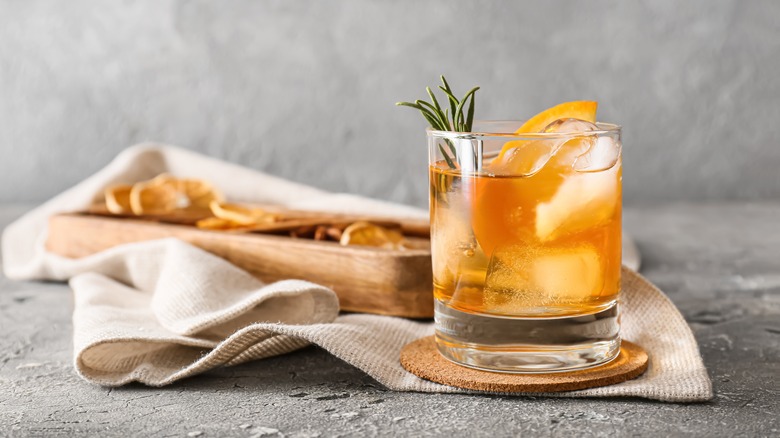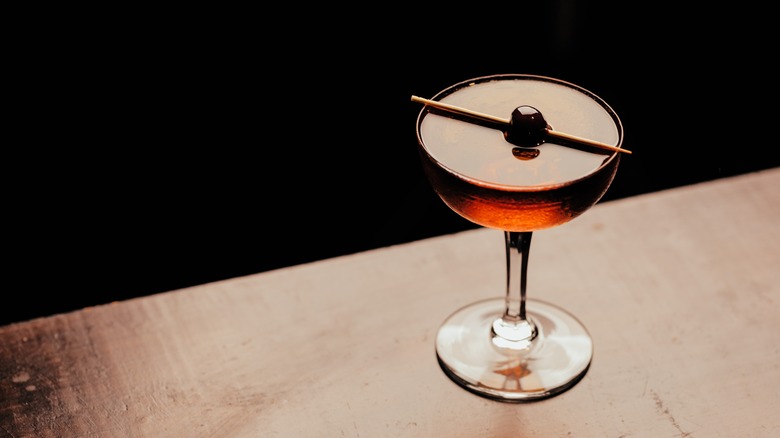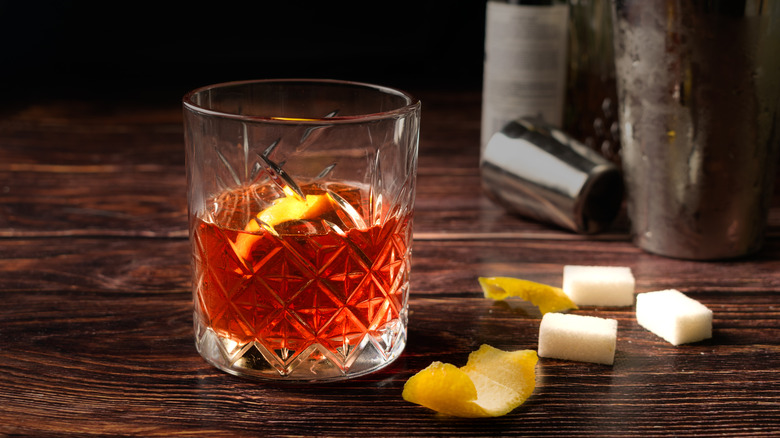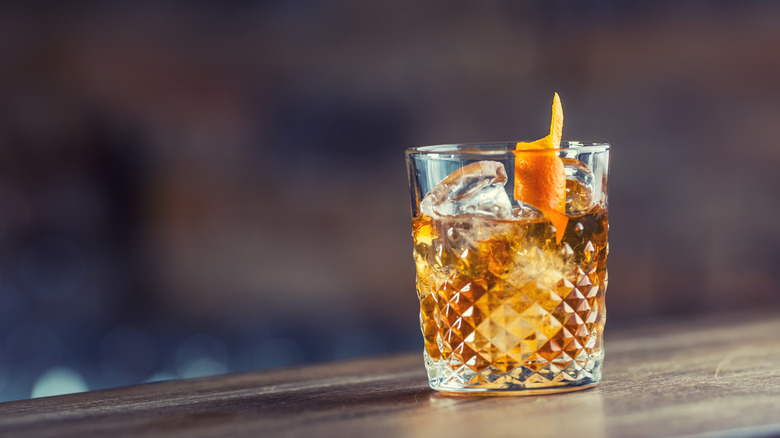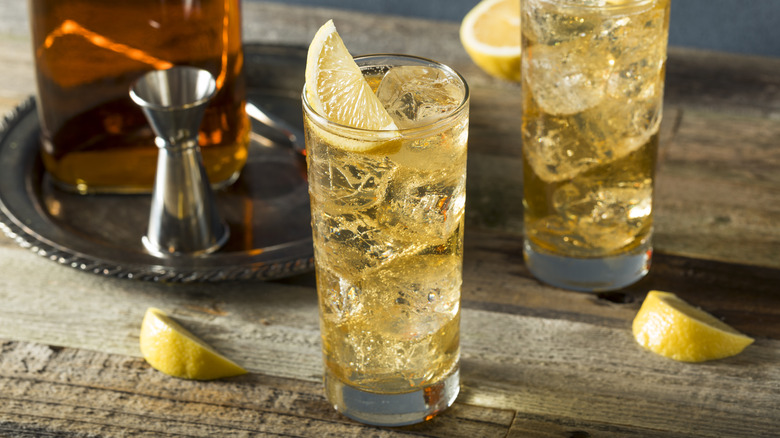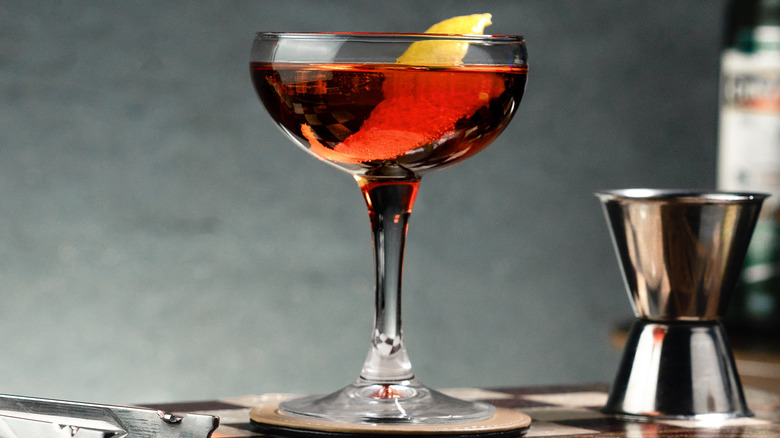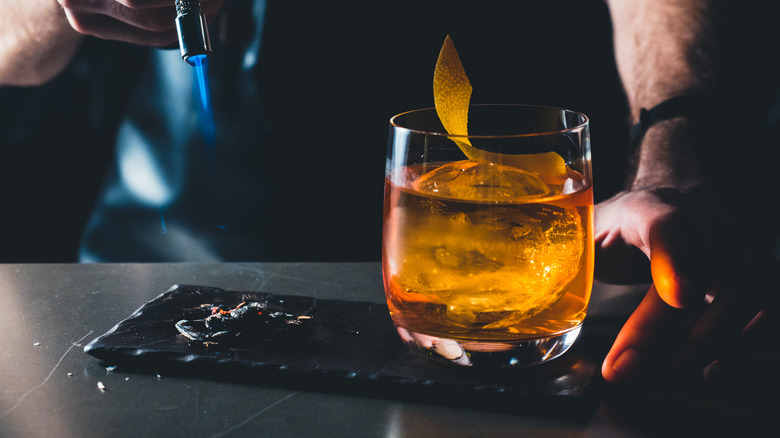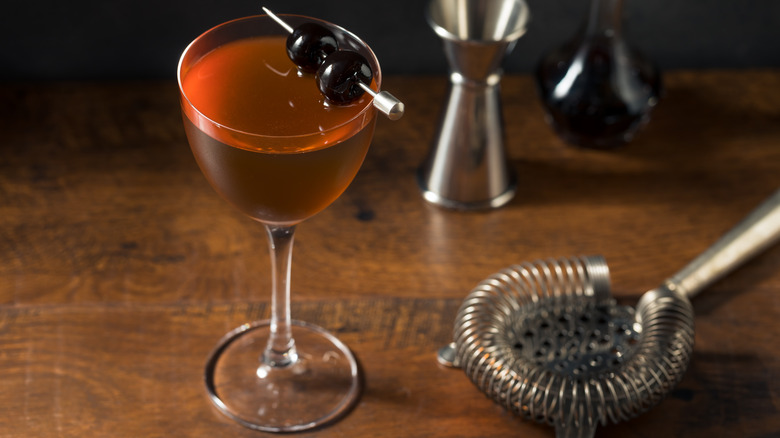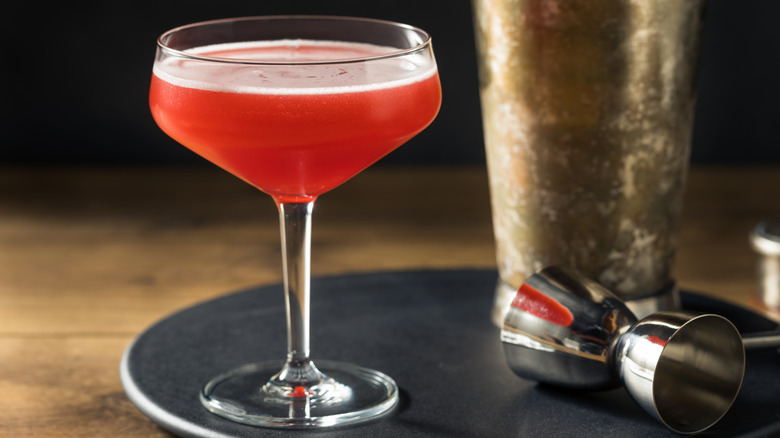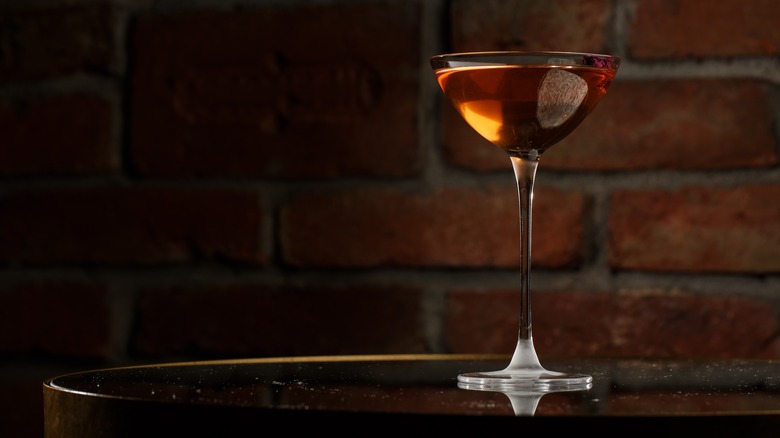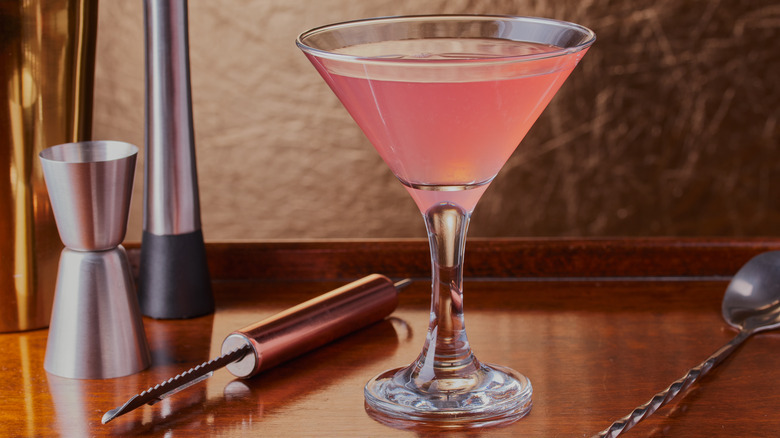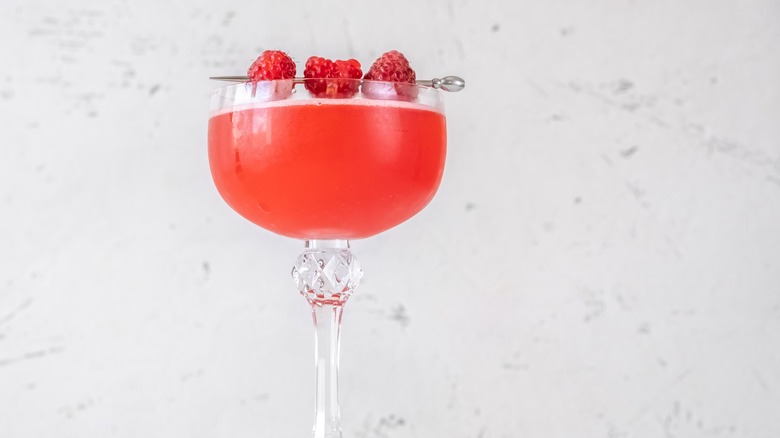15 Absolute Best Rye Whiskey Cocktails
When people think of American whiskey, bourbon is usually the first thing that comes to mind. However, bourbon is only half of the American whiskey world. The other half belongs to rye.
Rye whiskey is a spirit characterized by its mash bill or combination of grains a spirit is distilled from. In order to be considered a rye whiskey, the whiskey's mash bill must contain at least 51% rye grain. Most rye whiskeys contain more, but this is the minimum, and the difference can be made up of corn, barley, or any other grain.
The majority rye mash bill is what gives the whiskey its spice-forward profile, ripe with peppery notes that make it stand out from its sweeter bourbon counterpart. This unique character that is rich with barrel notes is great sipped on its own, but it also lends itself to cocktails. There are countless bourbon cocktails out there that are well-known and celebrated, but the world of rye is equally attributable to mixing drinks. Here are some to get you started.
Manhattan
The Manhattan is one of the most famous and long-standing cocktails out there. It is just as popular as any other drink in existence and it has sustained as a timeless staple for over a century.
The exact origins of Manhattan are unclear, and there are multiple theories regarding its exact invention. What is widely accepted, though, is that it first came about sometime in the 1880s and a recipe for the drink first appeared in Olean, New York's Sunday Morning Herald in 1882.
This recipe, and many of the early ones following it, simply called for whiskey, sweet vermouth, and bitters, not specifying which type of whiskey. However, once Prohibition was enforced, Canadian whisky was more easily accessible, so the use of rye whiskey for Manhattans became more prominent and it has stayed that way since.
Manhattans can certainly be made with bourbon whiskey if that is preferred, but purists will claim that rye is the only correct way to mix the drink. Regardless, the peppery and spicy notes of rye whiskey are complimented greatly by the Angostura bitters as well as by the botanicals in the vermouth. The Manhattan is a classic for a reason.
Sazerac
Some cocktails and spirits in general become synonymous with the city or country they belong to as an iconic piece of that location. The Sazerac is the quintessential cocktail for New Orleans, Louisiana.
The creation of the Sazerac is credited to Antoine Peychaud, whose invention of Peychaud's bitters has contributed to countless drinks beyond this one. Originally, Peychaud is believed to have mixed the first versions of this drink with his favorite cognac, Sazerac-de-Forge. Eventually the cognac was subbed out for rye whiskey, but the name of the cocktail stuck. Then absinthe was added to the mix in the 1870s, and the Sazerac has remained that way since.
Today, a classic Sazerac is made by mixing one sugar cube with Peychaud's bitters, 2 ounces of rye whiskey, and ¼ ounce of absinthe. If you like Old Fashioneds, the Sazerac is not too far off. Plus, this cocktail is the most fundamental way to try both Peychaud's bitters and absinthe, two unusual cocktail ingredients that will definitely expand your palate.
The Sazerac has a way of being totally unique while also tasting familiar and classic, even if you have never had one. This drink is the well-deserved pride of New Orleans, but has since been accompanied by the next cocktail on the list.
Vieux Carré
If you have visited New Orleans before, chances are you have been to the French Quarter. This is the most historic and popular neighborhood in the Big Easy, and the inspiration behind the name of this next cocktail.
In French, "Vieux Carré" translates to "old square," another name for the French Quarter. The cocktail's creation is credited to Walter Bergeron and was first published in the 1937 book "Famous New Orleans Drinks and How to Mix 'Em." The Vieux Carré may actually a better representation of New Orleans than the Sazerac, due to the former's recipe containing an abundance of French ingredients.
The Vieux Carré is made by mixing together rye whiskey, cognac, sweet vermouth, Benedictine, which is an herbal liqueur made in France, and Angostura and Peychaud's bitters. This cocktail is essentially a cross between an Old Fashioned and Manhattan with a distinctly French twist.
The rye whiskey's bold and sharp character is balanced out by the rich cognac, and the botanicals of the vermouth and Benedictine work with the bitters to create layers of complexity in every sip. This is another drink that is simple yet also full of discovery. Curious about which is the better New Orleans cocktail, the Vieux Carré or the Sazerac? It seems as though you'll just have to try both.
Rye Buck
The cocktail category of the buck is a large umbrella term that encompasses many different cocktails, some of which are not even called bucks. To qualify as a buck, a cocktail must be made up of a base spirit, citrus juice, and be topped with ginger beer.
The buck came about as an evolution of Rickey cocktails, which consist of a base spirit, lime juice, specifically, and regular soda water instead of ginger beer. Both Rickeys and bucks predate Prohibition and remain popular drinks today, no matter what they are called, and while the Rye Buck is one of the most basic rye cocktails, it is perhaps the most refreshing.
As mentioned earlier, the combination of spirit, citrus, and ginger beer is simply a match made in heaven. You can make a buck with virtually any spirit you want, and it is sure to turn out. Rye whiskey is particularly great because of its spice and barrel notes, which are natural compliments to the spiciness of ginger beer. Whether you call it a Rye Buck or a Rye Mule, mixing one up is a guaranteed success.
Old Pal
This next cocktail is the first and only Negroni variation on the list. The Old Pal was invented by Harry MacElhone, who also invented the more popular whiskey Negroni riff, the Boulevardier, made with bourbon. The Old Pal, however, substitutes two ingredients in the original cocktail's recipe, the gin out for rye whiskey and the sweet vermouth for dry.
The result is a sharp Negroni riff that is a perfect balance of spice, bitterness, and herbaceousness. As is the case with most Negroni variations, the equal parts template makes for a simple-to-make drink that is inherently balanced. The Old Pal is definitely a more assertive Negroni riff than most, as the vermouth swap allows the Campari to shine more, and rye whiskey is drier to begin with. If you like Negronis, though, the Old Pal is a must-try.
The drink is named after the customer MacElhone created it for and served it to the most. His name was Sparrow Robinson, and he always referred to people as his "old pal." So when MacElhone came up with the simple riff, he called it the same friendly name. It was first published in the 1929 edition of MacElhone's "Harry's ABC of Mixing Cocktails."
American Trilogy
The American Trilogy is one of the younger cocktails on this, and one that has cemented itself as a modern classic since its invention. The drink was created by bartenders Michael McIlroy and Richard Boccato at Little Branch in New York City. The idea behind this old fashioned variation is quite simple. It contains three distinctly American ingredients and is named accordingly.
These three ingredients, in addition to the regular sugar cube found in most old fashioneds, are American rye whiskey, applejack, and orange bitters. Applejack is perhaps the most American spirit that's ever existed. It is made by distilling hard apple cider using freeze distillation, or jacking, hence the name. Applejack was once one of the most popular spirits in America, specifically during the colonial era.
Although its popularity has dwindled in more recent years, the American Trilogy has helped introduce the spirit to many modern drinkers. Like most old fashioned riffs, this cocktail is super simple and its spirit-forward profile makes it a silky smooth pleasure. The sweetness of the Applejack is cut beautifully by the sharpness of the rye, and the other components provide the usual functions in any old fashioned. This cocktail is worth getting a bottle of Applejack by itself.
Greenpoint
The Greenpoint cocktail is a Manhattan variation but is actually a riff of a riff on the classic. The modern classic came about as a riff on the Brooklyn, which was invented soon after the popularization of the Manhattan. The Greenpoint is more similar to the original Manhattan and is made by mixing rye whiskey, sweet vermouth, and yellow Chartreuse.
The Greenpoint is named after a neighborhood in the borough of Brooklyn, New York, and is another cocktail courtesy of Michael McIlroy of Milk and Honey, a legendary bar in New York City. The rye whiskey and sweet vermouth give the timeless profile of a traditional Manhattan, which is tweaked by the yellow chartreuse. Chartreuse is a very unique herbal liqueur that was first made by the Carthusian monks in the French alps. Both yellow and green Chartreuse contribute to countless cocktails, and both deserve a spot on your home bar.
The Greenpoint's intense herbaceousness makes for an entirely new-tasting cocktail, reminiscent of the past but also reflective of the modern craft cocktail boom. This is one of the finest Manhattan variations around, and the perfect excuse to buy a bottle of yellow Chartreuse if you don't already have one.
Scofflaw
This next cocktail is a Prohibition-era drink that is another creation of Harry MacElhone, who came up with it at his bar in Paris in the 1920s. The Scofflaw was actually invented as a protest against Prohibition, despite being created outside of the U.S.
During Prohibition, a contest was held to come up with a name for people who did not adhere to the abolition of alcohol. The entry picked as the winner was "scofflaw," a reference to a drinker scoffing the law. Once word of this reached Paris, he came up with the Scofflaw cocktail, and the drink was included in "The Savoy Cocktail Book" published by Harry Craddock in 1930.
The Scofflaw is a shaken cocktail made with rye whiskey, dry vermouth, lemon juice, grenadine, and orange bitters. The result is a drink best described as a cross between a Manhattan and a whiskey sour. The lemon juice and grenadine make it one of the brighter and more vibrant rye drinks, and shaking the mixture makes it light and aerated. If you ever want to commemorate the end of Prohibition, the Scofflaw is the perfect way to do so.
Black Manhattan
The Black Manhattan is another Manhattan variation, this one that swaps out the sweet vermouth for Averna, an Italian amaro, and the bitters are split between Angostura and orange. It was first mixed in 2005 by San Francisco-based bartender Todd Smith.
This very simple take on the Manhattan turns what is a very approachable cocktail into one that is more bittersweet, with a greater presence of herbs and richness from the Averna. Unlike many Italian amari that are made in the north of the country and utilize botanicals from the alps, Averna is made with herbs, spices, and fruits from the Mediterranean. Averna has notes of caramel in addition to its botanicals, which keep it a well-balanced, bittersweet delight. The amaro is still made in Sicily, despite being owned by Milan-based Gruppo Campari.
If you like Manhattans, trying a Black Manhattan is a no-brainer. This variation is definitely unique and a great stand-alone cocktail in its own right, and a good use of one of the best, most popular amari on the market.
Ward Eight
Like many cocktails invented around the turn of the 19th century, the Ward Eight's origins are not exactly certain. What is confirmed, though, is that it is one of the few classic cocktails to be born in the city of Boston, and it became popular in Beantown and beyond in the early 1900s. Some credit the precise invention to one bartender, others to another, and the original recipe even remains unknown.
There have been many iterations of the Ward Eight, which has been reinvented time after time since there is no universally accepted creation of the drink. The most common one today, however, consists of a combination of rye whiskey, lemon juice, simple syrup, orange juice, and grenadine shaken together and strained into a coupe glass.
If you ask 10 bartenders to make a Ward Eight, you may get 10 different recipes, but you can expect some combination of the ingredients listed above. While this could be perceived as an unfavorable characteristic, this actually makes the Ward Eight a very customizable cocktail. After all, all the ingredients are sure to make a great drink, so finding the measurements that work best for you only makes the cocktail that much more enjoyable.
Blinker
The Blinker is another classic cocktail whose earliest known origins date back to 1834 when it was included in Patrick Gavin Duffy's "The Official Mixer's Manual." The original recipe, however, was quick to be altered by Ted Haigh, otherwise known as "Dr. Cocktail," who solidified the recipe as two ounces of rye whiskey, half an ounce of grapefruit juice, and one bar spoon of raspberry syrup.
The Blinker has long sat uninteresting and unpopular since its creation, and it was only until recent years that the Hollywood graphic designer and mixology historian Haigh basically reinvented it. Now, the Blinker is here to stay as a super simple drink that is definitely different than most other rye whiskey cocktails.
One of the keys to the Blinker, as Haigh points out, is the type of grapefruit juice used. The more common red grapefruit has sweeter juice, which may throw the Blinker off balance if used. White grapefruit juice, on the contrary, is more bitter, and a better option for the cocktail. Raspberry syrup is very easy to make at home, and if you do decide to make a batch, you can use it for many cocktails other than a Blinker.
Rye and Ginger
This next cocktail is one that is definitely not as straightforward as its name suggests. Upon first reading it, you may assume the Rye and Ginger is just a two-ingredient cocktail, but it is much more than that.
The Rye and Ginger was created at Blacktail, a New York City bar, by bartender Jesse Vida. The drink consists of rye whiskey, Zucca amaro, fig syrup, lemon juice, lemon sherbet, and ginger ale. Ideally, it would be better to use malic acid instead of lemon juice. Malic acid is what gives citrus its tartness, and can be bought in a flavor-neutral powder form.
All of the ingredients, excluding the ginger ale, are combined in a highball glass with ice and then topped with ginger beer. This drink will make you rethink everything you thought you knew about highball cocktails, which are typically very simple and uncomplex. The Rye and Ginger takes the highball to another level, full of ingredients like fig syrup and lemon sherbet that are hard to find in other drinks, but come together beautifully in this one.
Rye Old Fashioned
The old fashioned is obviously one of the most classic cocktails. It dates back to the mid-1800s, when it was believed to be invented by James E. Pepper, who requested a cocktail made in the "old fashioned way" in a bar in Kentucky, and he received a combination of bourbon, sugar, and bitters. He took his newfound favorite drink to NYC, and the old fashioned has more or less stayed the same since.
Using rye whiskey to make an old fashioned is a great substitute essentially for the same reason it is great in a Manhattan. The spiciness of rye and the rich barrel notes make for a more prominent base spirit in the cocktail, which is enhanced by the flavor of the Angostura bitters.
If the old fashioned is one of your go-to cocktails and you are looking for a way to make it more exciting or just to try something different, rye whiskey will accomplish this. Using bourbon to make an old fashioned is more traditional, but given the countless variations and reinventions of the drink, simply replacing it with rye whiskey is a far cry from heresy.
Satan's Circus
This next cocktail is courtesy of another New York City-based cocktail bar, The NoMad Bar. Satan's Circus was created by Leo Robitschek, who infuses Aperol with Thai chiles to make the cocktail. The other ingredients are rye whiskey, Cherry Heering, and lemon juice, which are all shaken together and strained into a coupe glass.
This infusion is easily one you can do yourself right at home, so do not think this is a cocktail you can only try in New York. All you have to do is combine your bottle of Aperol with ten halved Thai Bird chiles and let it sit for a few minutes. Strain it back into the Aperol bottle and you are ready to mix the drink. That's really it.
Two ounces of rye whiskey and ¾ of an ounce each of the infused Aperol, Cherry Heering, and lemon juice make for a truly one-of-a-kind cocktail that is boozy, bright, spicy, and effortlessly drinkable. Despite the intensely-flavored Aperol, the rye remains a formidable base for the drink that lends its peppery spice to the hot spice of the chiles. The name "Satan's Circus" really could not be any more fitting.
Rye Fizz
The last cocktail on the list is the Rye Fizz. Fizzes are another category of drinks that are normally just called sours; they consist of spirit, citrus, and simple syrup, that are lengthened with soda water. The Gin Fizz is the most popular of this realm of drinks, but this particular Rye Fizz restructures the cocktail entirely.
Fizzes are generally enjoyed in the summertime because of their effervescence and light character, but this rye fizz is made fit for autumn. It consists of rye whiskey, Angostura bitters, lemon juice, maple syrup, and an optional egg white. The mixture is shaken vigorously, strained, and topped with soda water, a fall-inspired rendition that remains bright and bubbly.
You can even take the autumnal goodness a step further with how you garnish this drink. Fizzes are traditionally left garnish-less because the egg white is enough of a spectacle itself, but some freshly grated cinnamon or nutmeg are just two ways you can make this cocktail even better.
